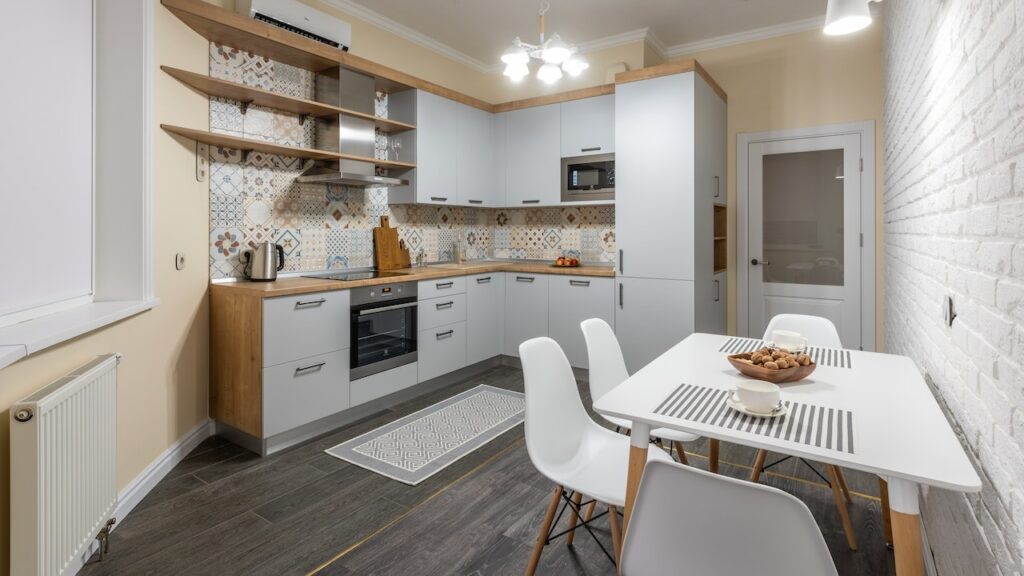The decision to put a rug in a small kitchen is one that depends on various factors, including your design preferences, practical needs, and the specific layout of your kitchen. While adding a rug to a small kitchen can enhance its aesthetics and comfort, it’s important to carefully consider the advantages and potential drawbacks of this choice. In this comprehensive guide, we will explore the considerations, benefits, and tips for using rugs in small kitchens to help you make an informed decision.
- Aesthetic Enhancement: One of the primary reasons to use a rug in a small kitchen is to enhance its visual appeal. A well-chosen rug can introduce color, pattern, and texture to the space, adding personality and style to an otherwise utilitarian room.
- Comfort Underfoot: Kitchens often have hard and cold flooring materials like tile or hardwood. A rug can provide a comfortable and warmer surface underfoot, making it more pleasant to stand on while cooking or doing kitchen tasks.
- Sound Absorption: Rugs have sound-absorbing properties, which can help reduce noise in a kitchen with hard surfaces. This can be particularly beneficial in open-plan layouts where the kitchen flows into the living or dining area.
- Zone Definition: In open-concept spaces, a rug can help define the kitchen area, especially when it’s used as a boundary marker between the kitchen and the adjacent living or dining area. This can create a sense of separation without the need for physical barriers.
- Protection: Rugs can protect the underlying flooring from wear and tear, spills, and stains. This is especially useful in high-traffic areas or under kitchen workstations where spills are likely to occur.
Considerations for Using a Rug in a Small Kitchen
- Size: Choosing the right size rug is crucial. In a small kitchen, a rug that is too large can overwhelm the space, while a rug that is too small may not serve its purpose effectively. Measure the area where you intend to place the rug and select an appropriate size.
- Safety: Safety is paramount in a kitchen. Make sure the rug has a non-slip backing or use a rug pad to prevent slips and falls, especially in areas prone to moisture or spills.
- Maintenance: Kitchens are high-traffic areas where spills and food crumbs are common. Consider the ease of cleaning and maintaining the rug. Opt for a rug that is stain-resistant and easy to spot clean or wash when needed.
- Style and Material: Choose a rug that complements the style of your kitchen and your overall home decor. In terms of material, consider one that is suitable for a kitchen environment, such as a low-pile rug that is less likely to trap dirt and debris.
- Layout and Traffic Flow: Think about the layout of your kitchen and the flow of foot traffic. Avoid placing a rug in areas where it may become a tripping hazard or obstruct the natural traffic flow.
- Practical Zones: If you have specific work zones in your kitchen, such as a cooking area or a sink area, consider placing the rug strategically in these zones to provide comfort and protection where it’s needed most.
Tips for Using Rugs in Small Kitchens
- Select the Right Size: Measure the available space in your kitchen and choose a rug size that fits comfortably without overwhelming the area. Common options include runner rugs for narrow spaces or smaller accent rugs.
- Coordinate Colors: Coordinate the rug’s colors with your kitchen’s color scheme to create a harmonious and cohesive look. You can either choose a rug that matches existing colors or one that adds a pop of contrast and interest.
- Layering: Consider layering a smaller rug on top of a larger one for added visual interest and depth. This technique can work well in kitchens with open-plan layouts.
- Easy Maintenance: Opt for a rug that is easy to clean and maintain. Look for materials that are stain-resistant and machine washable if possible. This will help keep your kitchen rug looking fresh.
- Non-Slip Backing or Rug Pad: Ensure the rug has a non-slip backing or use a rug pad underneath to prevent accidents and keep the rug securely in place.
- Durable Material: Choose a rug made from durable materials that can withstand the demands of a kitchen, such as spills, foot traffic, and frequent cleaning.
- Placement: Consider placing the rug strategically under key areas like the sink or prep area to provide comfort and protection where it’s most needed.
Examples of Rug Placement in Small Kitchens
- Under the Sink: Placing a small rug under the sink area can provide comfort while doing dishes and protect the floor from water splashes.
- In Front of the Stove: A rug in front of the stove can serve as a cushioned mat while cooking and catch spills and food crumbs.
- Runner Along the Countertop: A narrow runner rug along a countertop can define the workspace and add a touch of style to the kitchen.
- In the Breakfast Nook: If your small kitchen includes a breakfast nook or dining area, consider placing a rug under the dining table and chairs to create a cozy and defined dining space.
- Boundary Marker: Use a rug to delineate the kitchen area in an open-plan layout, such as between the kitchen and the living room or dining area.
Conclusion
The decision to put a rug in a small kitchen should take into account your design preferences, comfort needs, and practical considerations. Rugs can enhance the aesthetics and comfort of a kitchen while serving functional purposes such as protection and sound absorption. By selecting the right size, material, and placement, you can successfully incorporate a rug into your small kitchen to create a more inviting and visually appealing space.


